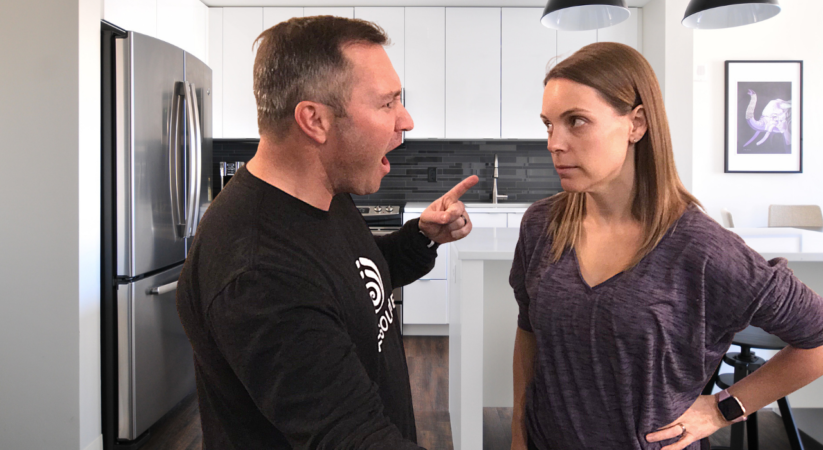Pinpointing Your Communication Style
It’s important to know what your own communication style is before you learn to communicate effectively. This is true for both the personal and professional sides of your life. So, how can you figure out your communication style? First, you need to know what the different styles are called and how they affect your conversation. This post will focus on just one style, so be sure to check out my other posts to find out more about the other three communication styles. If you think you might be an aggressive communicator, you’re in the right spot.
The Aggressive Communicator
As apposed to being passive while communicating, which you can read about here, an aggressive communicator wants everyone to know his or her opinion…immediately. They are loud, clear, and often harsh when getting their point across. This kind of communicator comes off as confident and straightforward, and is likely the person in a group setting who speaks up often. Aggressive communicators can be seen as the “bully” of a conversation, but they can also helpful, as you’ll see later. Does this sound like you or someone you know?
Communication: Being Aggressive
B! E! A-G-G! Rrrr-E-S-S-I-V-E! Be aggressive, be be aggressive! (Any other cheerleader wannabes out there? I wasn’t good enough to be on the squad, but I did my darnedest from the stands!) Being aggressive, while playing sports anyway, was a pillar of wisdom when I was in junior high and high school. Even being aggressive while driving is sometimes encouraged, especially to someone who is a newbie. Better to be safe and follow the rules of the road than hesitate and cause an accident, right?
Well, why isn’t being aggressive while communicating fortified from an early age?
Here’s why: it’s not always kind. I’m a big proponent of being kind, and a kind person takes turns and is a good listener while conversing, whether it be one on one or in a group setting. Feel free to disagree with me on this, as I’m only here to write my opinion based on my own knowledge and experiences.
Are you, indeed the aggressive communicator?

If you’re an aggressive communicator, you probably haven’t quite realized it yet. You are often unaware of anything or anyone else during your conversations. I’m not trying to be mean, promise! I’m just saying that aggressive communicators are, well, aggressive, which by definition means “ready to attack,” or “forceful in nature.” If this is you, take a minute to re-evaluate your participation in conversations. I’m not saying you have to back down and stop having input, I just want you to see things from another angle. Your aggressive style can still be helpful in multiple situations, but you have to control your predisposition to make everyone hear you immediately. Being aggressive doesn’t have to be negative.
Managing Aggressive Communicators
If you are in a conversation with an aggressive communicator, you can reign in the emotions with a quick boundary check. Before you engage in conversation with this person, list a couple of things you’d like to achieve and then a few guidelines for how it will go down. Be direct and simple, yet not too forceful. In my experience, an aggressive communicator does not want to hear aggression come back towards him, so play nice! Be patient and model your responses in a way that you want to be spoken to. Aggressive communicators often interrupt, so calmly redirect if this happens.
You might be an aggressive communicator if…
Once upon a time there was a little boy who wasn’t listening to his mama. The little boy was only 5 years old, but he sure had a temper. The little boy’s mama often responded with a firm “no thank you”, but in rare circumstance, she could scare the pants off her kiddos with her yell. Well, on this particular day, the little boy was being so disobedient that his mama let out a loud roar, demanding that he go spend some time alone in his bedroom. In true 5-year-old-temper-tantrum style, the little boy stomped up the stairs and slammed the door. His frustrated and angry mama followed him upstairs in an attempt to have a conversation about his actions. This conversation involved multiple grunts and interjections from the 5-year-old, and numerous deep breaths from the 5 year old’s mama (who was beginning to realize that she needed to let him be the only aggressive communicator in the room). By the time the conversation was over, the little boy was sitting in his mama’s lap, crying and apologizing for his behavior.
What does this have to do with aggressive communicators?
Well, for a 5 year old, this little boy is definitely on the aggressive communicator track. While it might seem normal for a little boy to act like this while he’s learning to control his emotions, it’s also important, as a parent, to nurture a more effective communication style. If you can recognize your child’s communication style, you can more easily respond in conversations that become heated. If you haven’t guessed, the little boy and the mama from the story above are my son and I. He isn’t always aggressive, but as I said, he’s still learning how to communicate his emotions, so tantrums do happen. I have identified this as a pattern of behavior and changed my reaction accordingly to manage his aggressive style. Remember above when I mentioned that aggressive communicators don’t like aggressive counterparts? The same goes for kids. An aggressive, shouting parent will not effectively convey his or her thoughts when the child is also being aggressive. Parents: take a deep breath, stay calm, let your kids explode, then talk it out. You can still be firm without being aggressive. Five years old might be too young to start reasoning, but with older children, appeal to their emotions and idea of right and wrong. In my experience, this can be more powerful than any amount of screaming. I’ve often had to use this approach as a teacher, and I’ve found that being calm and showing respect toward an aggressive communicator can be just the ticket to reach them behind their aggression.
Aggressive Communicators: What did we learn?
The aggressive communicator wants to be heard, and wants to be heard first. He/she has the tendency to interrupt often and disagree openly and freely. If you are an aggressive communicator, you can learn to adjust your style by taking deep breaths, pausing, listening and observing more than usual. You can use your aggressive inclinations to effectively get your point across, but don’t be alarmed if you’re not heard first or if someone interjects before you. Learn from your conversations and grow from your experiences. Being aggressive while communicating doesn’t have to be totally negative…you can use your aggressive style to gain attention, if you must, but dial it back and earn the respect of your audience after that. If you’re on the opposite end of the aggressive communicator, you might also need to take deep breaths, but yours are to calm yourself and give yourself courage to set boundaries before the conversation becomes too heated. On a more personal level, model your own input in a way that the aggressive communicator has no choice but to learn how to converse more effectively.
If you want to learn more about communication styles, check back soon for the next blog post! You can also visit our LifeSoldier Living YouTube Channel to hear from my husband and learn his perspective on communication styles.





